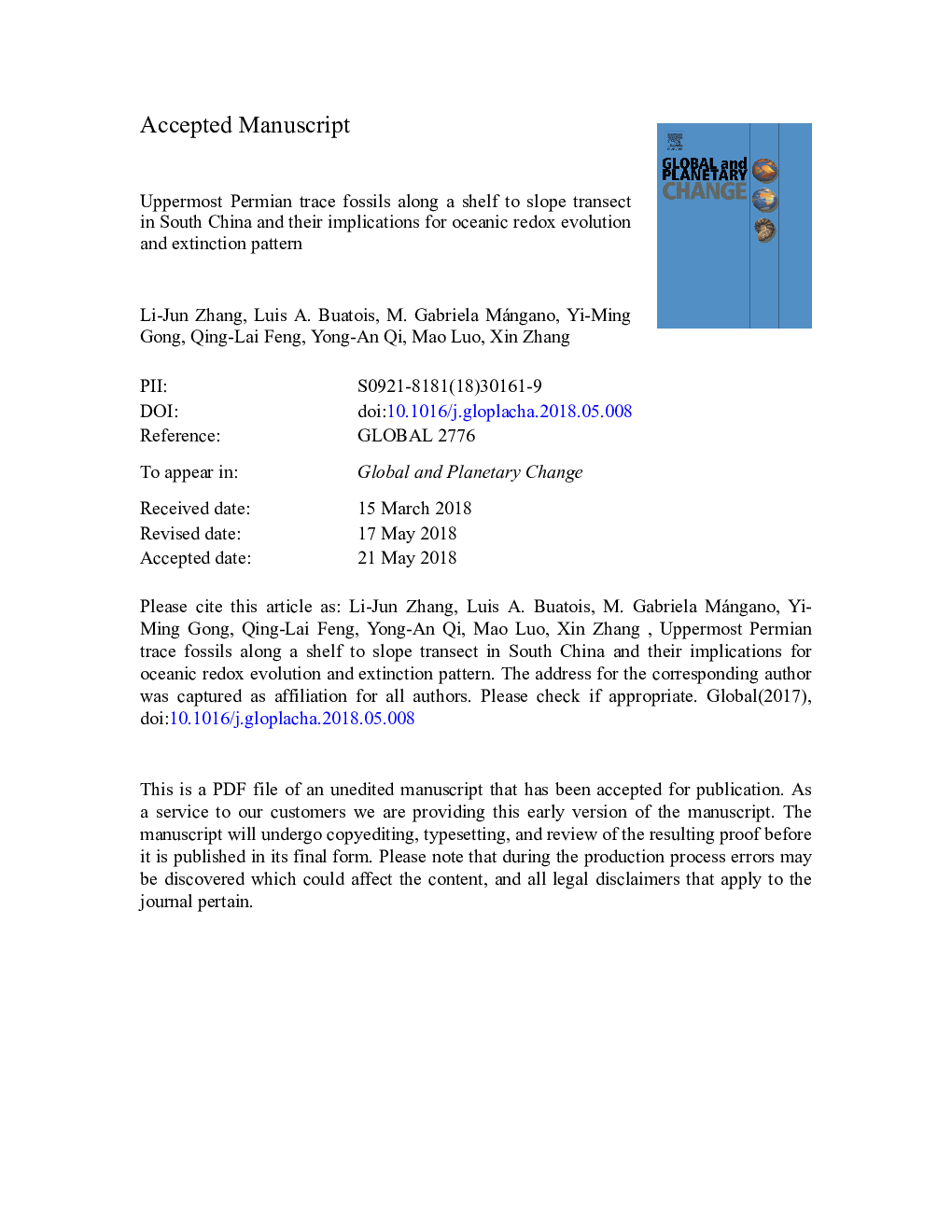| کد مقاله | کد نشریه | سال انتشار | مقاله انگلیسی | نسخه تمام متن |
|---|---|---|---|---|
| 8867474 | 1621615 | 2018 | 38 صفحه PDF | دانلود رایگان |
عنوان انگلیسی مقاله ISI
Uppermost Permian trace fossils along a shelf to slope transect in South China and their implications for oceanic redox evolution and extinction pattern
ترجمه فارسی عنوان
بیش از حد پرمین فسیل ها را در امتداد یک قفسه به شیب زاویه در جنوب چین و پیامدهای آنها برای تکامل اقیانوس آرام و الگوی انقراض
دانلود مقاله + سفارش ترجمه
دانلود مقاله ISI انگلیسی
رایگان برای ایرانیان
کلمات کلیدی
موضوعات مرتبط
مهندسی و علوم پایه
علوم زمین و سیارات
فرآیندهای سطح زمین
چکیده انگلیسی
Trace fossils are important evidence of benthic activity and proxies of bottom and interstitial water oxygen content, making them a promising tool to understand the oceanic redox evolution and extinction patterns during the end-Permian mass extinction (EPME). Detailed bed-by-bed ichnologic studies were performed at a high-resolution scale from two uppermost Permian sections (Shangsi and Dongpan) in South China, documenting the presence of Chondrites targionii, Chondrites isp., Nereites isp., Planolites isp. A, Planolites isp. B, Palaeophycus isp., Phycosiphon incertum, Thalassinoides isp., and Zoophycos isp. The uppermost Permian strata at the Shangsi section mainly comprise siliceous limestone interbedded with illite-montmorillonite claystone and shale, recording a deep shelf setting. The uppermost Permian strata at the Dongpan section consist of mixed chert, mudstone and claystone, formed in a slope environment. Bioturbation index in uppermost Permian strata is mostly 1-2, but with thin intervals reaching 3-4. Fluctuating bioturbation intensities, ichnofaunal composition (Thalassinoides, Planolites, Zoophycos) and ethologies, as well as the ratio of highly reactive iron to total iron (FeHr/FeT) and the proportion of the highly reactive iron pool in the form of pyrite (Fepy/FeHR) suggest that bottom and interstitial oxygen levels were not permanently anoxic/euxinic, but were interrupted by brief periods of aerobic conditions during the latest Permian. Three bioturbation phases in the EPME are identified. Phase I is characterized by the absence of typical pascichnia ichnotaxa (e.g. Nereites isp.) and relatively large fodinichnia burrow (e.g., Planolites isp. B; Zoophycos isp.). Phase II mainly consists of smaller Planolites isp. A, Thalassinoides isp. and Chondrites isp., recording a transition from softground to firmground. Only occasional smaller Planolites isp. A occur in Phase III without any associated vertical burrows. Ichnodiversity and bioturbation index from Phase I to Phase III show a step by step decline, corresponding to the two-stage extinction patterns. Long-term environmental stress (e.g., oceanic anoxia, volcanic winter, global warming, ocean acidification, hypercapnia) may have played major role in the collapse of the infaunal ecospace and only facies-crossing, highly tolerant, opportunistic organisms may have persisted in otherwise vacant ecological niches in the aftermath of the extinction.
ناشر
Database: Elsevier - ScienceDirect (ساینس دایرکت)
Journal: Global and Planetary Change - Volume 167, August 2018, Pages 74-86
Journal: Global and Planetary Change - Volume 167, August 2018, Pages 74-86
نویسندگان
Li-Jun Zhang, Luis A. Buatois, M.Gabriela Mángano, Yi-Ming Gong, Qing-Lai Feng, Yong-An Qi, Mao Luo, Xin Zhang,
